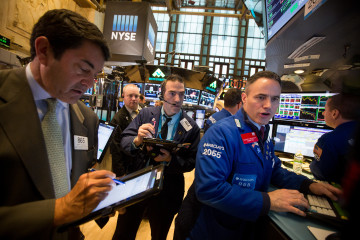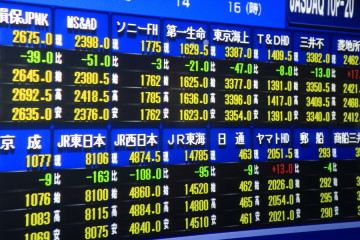Dollar Suffers Worst Day in 7 Years as Traders Face Fed Reality

©2016 Bloomberg News
O1ZSAS6KLVRD
(Bloomberg) — The dollar plunged by the most since the Federal Reserve announced the start of its Treasury bond-buying program seven years ago, as signs of a slowing U.S. economy helped derail bets on diverging policies between global central banks.
The U.S. currency sank at least 1.7 percent against nine of its biggest peers amid concern that growth in the world’s largest economy is cooling. Currency traders are catching up to the bond market, where 10-year yields sank to the lowest in a year Wednesday and futures are sending the strongest signal yet that traders expect the Fed to stand pat this year.
“The currencies market has been at odds with the rates market, and now the rates market is winning,” said Peter Gorra, head of foreign-exchange trading in New York at BNP Paribas SA. “There’s a disconnect where the Fed says it’s four hikes while the market says it’s like 0.7 hike this year — someone is wrong.”
Concern about a global demand slump and policy makers’ response to a slowing growth worldwide has put the $5.3 trillion-a-day market in disarray. The dollar’s pullback this week has reversed all the yen’s decline against the greenback on Friday when Bank of Japan introduced negative interest rates to revive inflation, which is stuck near zero.
The Bloomberg Dollar Spot Index, which tracks the U.S. currency against 10 global peers, slumped 1.7 percent as of 5 p.m. in New York. It dropped as much as 1.9 percent, the biggest loss since 2009 when the Fed opened another front in its battle to boost the economy by pledging to buy as much as $300 billion of Treasuries and stepping up purchases of mortgage bonds.
The dollar slid 1.7 percent to 117.90 yen, erasing all the gains since the Bank of Japan’s surprise Jan. 29 move to negative interest rates on certain deposits. The greenback fell 1.7 percent to $1.1105 per euro, the lowest since October.
Fed Watch
New York Fed President William C. Dudley said in an interview with Market News International that policy makers are “acknowledging that things have happened in financial markets and in the flow of the economic data that may be in the process of altering the outlook for growth and the risk to the outlook for growth going forward.”
A report showed U.S. service industries expanded in January at the slowest pace since 2014, dimming the outlook for growth.
The bond market’s balance tipped toward zero rate hikes this year. Futures show traders expect the Fed’s effective rate to reach 0.495 percent by year-end. That level is closer to the current effective overnight rate of 0.38 percent than it is to 0.625 percent, where it may stand if the central bank raises its target range by a quarter-point again, following liftoff from near zero in December.
The January employment report on Feb. 5 may determine whether the dollar selloff will continue. The payroll data will show the U.S. created fewer than 200,000 jobs for the first time since September, according to economists surveyed by Bloomberg.
“Presumably investors are betting that lingering risk-off will stay Fed’s hand when it comes to further tightening,” said Valentin Marinov, head of Group-of-10 currency strategist at Credit Agricole SA’s corporate and investment banking unit in London. “It would take disappointing U.S. data today and Friday to see the dollar coming under sustained selling pressure.”
To contact the reporters on this story: Lananh Nguyen in New York at lnguyen35@bloomberg.net; Andrea Wong in New York at awong268@bloomberg.net To contact the editors responsible for this story: Boris Korby at bkorby1@bloomberg.net Paul Cox







No Comment